May 2020 saw me afield in Wisconsin using a gun I never would’ve considered turkey hunting with even a few years ago: a .410 bore shotgun.
One of my earliest firearm experiences was with an over-and-under, sporting a single-shot .22 long rifle on top and a single-shot .410 on the bottom. Over the course of a summer weekend, myself, two other boys about my age (9 or 10 I believe) and two adult males shot the over-and-under for a number of hours, the adults teaching us kids how to aim and pull, not jerk the trigger.
I still remember the smell of the gun powder from the .22LR’s as we pegged tiny, rimfire holes in paper targets and the relative roar of the .410 as empty pop cans toppled over from a spattering of birdshot.
The adults also made it clear: the .410 was a little-bitty gun. Of course, we had to follow the rules of safe shooting even with this smaller shotgun. But an adult, a man, would be using a 12 gauge for actual hunting, we were told, and this was all just practice to ready us for the big time.

Decades later, I still viewed the .410 as a kid’s gun, a pop can killer. But then the social media stories started, with people taking turkeys with .410’s—at distances of 30 yards and better!
Flukes and lucky shots, I assumed.
The stories kept circulating, though, and I started paying attention. These hunters were all using the new TSS or Tungsten Super Shot loads. Tungsten is denser than lead and harder, so ammunition makers are able to fit more tungsten pellets of smaller sizes into shells versus their lead counterparts. The result? Tighter patterns at longer distances with TSS loads compared to their lead cousins.
Now, TSS loads in 12 and 20-gauges were garnering rave reviews from hunters. But the .410 bore offerings surprised me. And, they appeared…to work? Hmm…
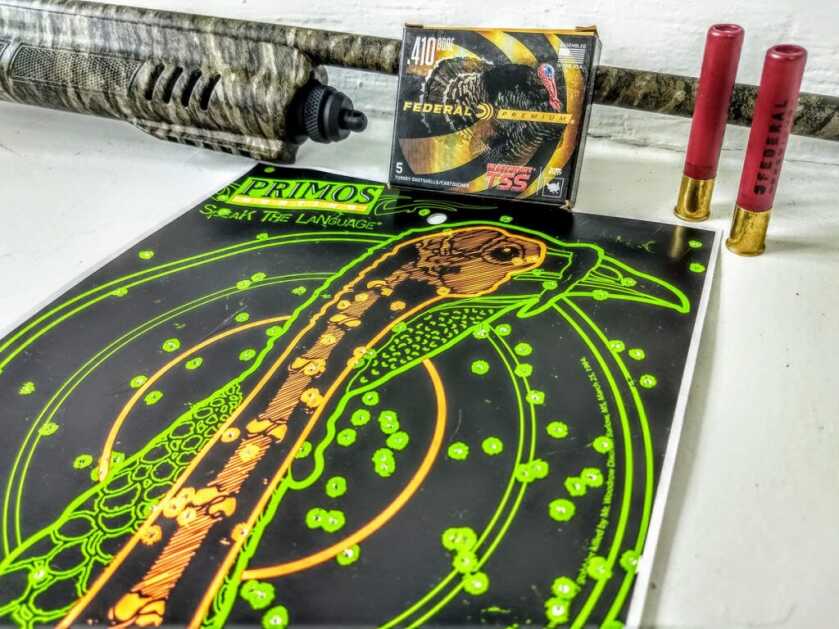
I decided it was time to see for myself. I ordered a new .410 shotgun and a selection of shells, did some testing and patterning, and then headed afield to see if I could bring down a tom or jake with the little-bitty scattergun.
The Gun
For my first serious foray into .410 hunting started with an Escort PS Turkey Hunter manufactured in Turkey and imported into the US by HATSAN USA.

The gas-operated, semi-automatic PS Turkey Hunter features Hatsan’s FAST Loading System, which enables faster and easier loading with one hand and without the need to change shooting position. The loading button acts as both a carrier latch release for loading and the bolt release when the bolt is locked back.
My PS Turkey Hunter .410 was finished in Mossy Oak Bottomland pattern and is also available in RealTree APG. The .410 arrived with three interchangeable, extended chokes: Full, Modified, and Improved Cylinder. I used the Full choke for my patterning and hunting.
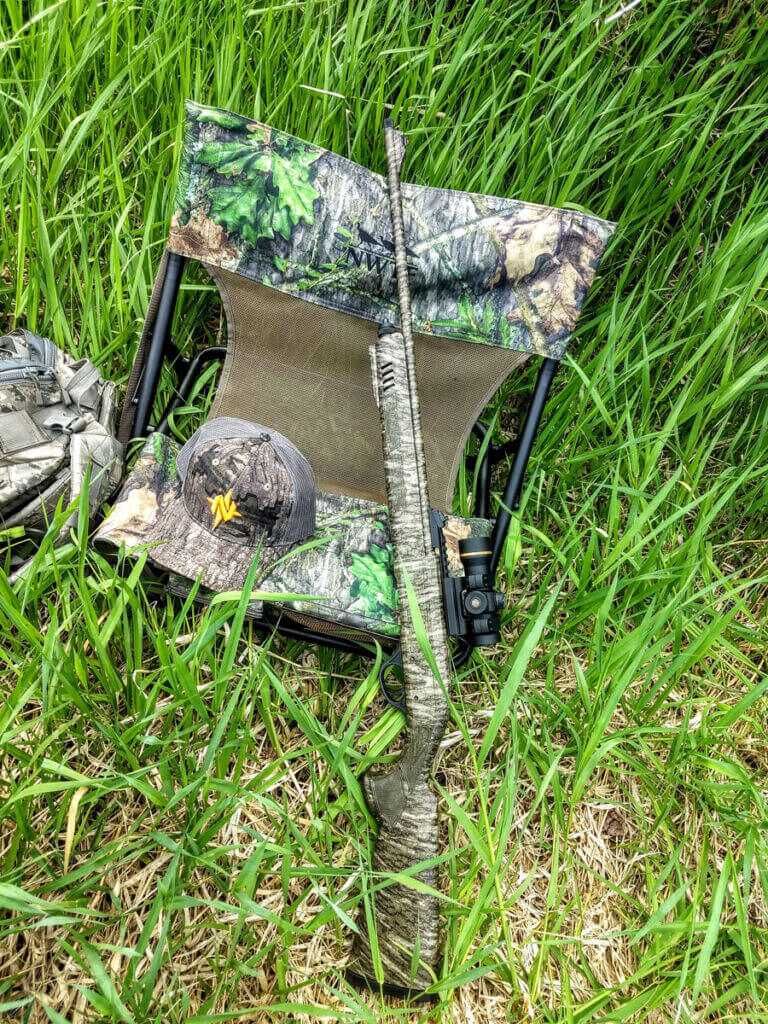
The PS Turkey Hunter features a 5-inch long cantilever optics rail, with four cross-slots to accommodate a variety of Weaver mounts. The gun is equipped with bright fiber optic front and rear sights for low-light hunting and is also available in 12 and 20-gauge.
The shotgun’s 24-inch barrels is hard-chrome lined for maximum durability and corrosion resistance. In .410, this is a lightweight gun at just six pounds unloaded, and only 44-inches long. Recoil was minimal.
The PS Turkey Hunter was a pleasure to shoot at the range, and nimble and handy in the field. The MSRP is $499.00, which translates to street prices closer to $400, a really good value given how well it performed for me.
The Optic
I wanted the shotgun equipped with an optic, and I chose the Leupold Freedom Red Dot Sight (RDS) with a 1 MOA red dot.

Built around a tough, 34mm main tube, the RDS measures just under 5.5 inches in length, and the scratch-resistant lenses feature Leupold’s Twilight Red Dot System for clear and color-correct images. The RDS is 100-percent fog proof and waterproof and features 80-MOA of adjustment in both elevation and windage.
The RDS incorporates Leupold’s battery-saving Motion Sensor Technology (MST), which puts the sight into a battery-saving standby mode after five minutes of inactivity. When the MST detects motion, it instantly activates the sight. A manual mode allows the sight to be shut off when not in use, too.

I had used and reviewed the RDS previously and found it to be accurate and easy to zero. To read my GunsAmerica Digest RDS review and specs click here.
The Shells
My shooting and patterning began with two non-turkey hunting loads: Rio Ammunition’s .410 Top Target shells, 2 ¾-inches long, and carrying a ½-ounce of #6 shot; and Winchester Super X shells, 3-inches and loaded with ¾-ounce of #7.5 shot.
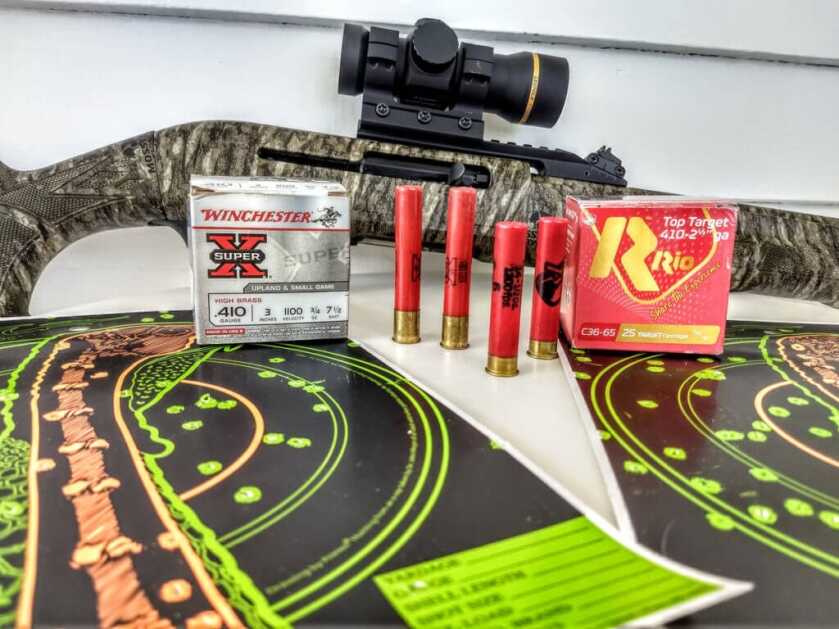
I used these two loads as baselines to see what I could expect from basic .410 offerings at 20 yards, and to then determine if the new-and-improved TSS loads really were an improvement.
The Rio Top Targets and Winchester Super X worked flawlessly in the PS Turkey Hunter, and at 10 to 15 yards would kill a turkey. But the patterns were already spotty at 20 yards, and I wouldn’t advise using them.
Of course, and to re-iterate: these .410 loads were not made for taking on big toms and I used them only to get baseline patterns.
Next, I used three brands of turkey hunting .410’s, each loaded with tungsten pellets: APEX Ammunition’s Turkey TSS loaded with a 27/32-ounce of 9.5 Shot; Browning’s TSS Tungsten Turkey, with 13/16ths-ounce of #9 shot; and Federal Premium’s Heavyweight TSS with 13/16ths-ounce of #9 shot.
Each of these brands were three-inch shells.
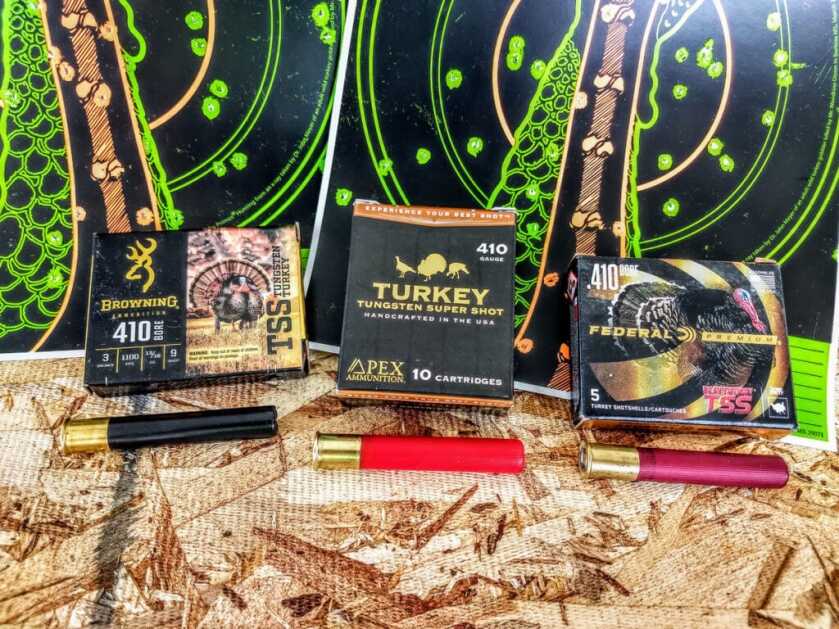
The Patterns
First, I zeroed the PS Turkey Hunter with a brand at 20 yards, then I shot for patterns at 20, 30, and 40-yards, using my favorite gobbler practice targets, the Primos VisiShot Turkey Targets.
At 20 yards, all three of the TSS loads were definite turkey killers, with the three brands averaging right around 20 pellets in the target vital zones.
At 30 yards, Federal TSS averaged 15 pellet hits in the vital zones, the APEX 17 pellets, and the Browning 19 pellets.
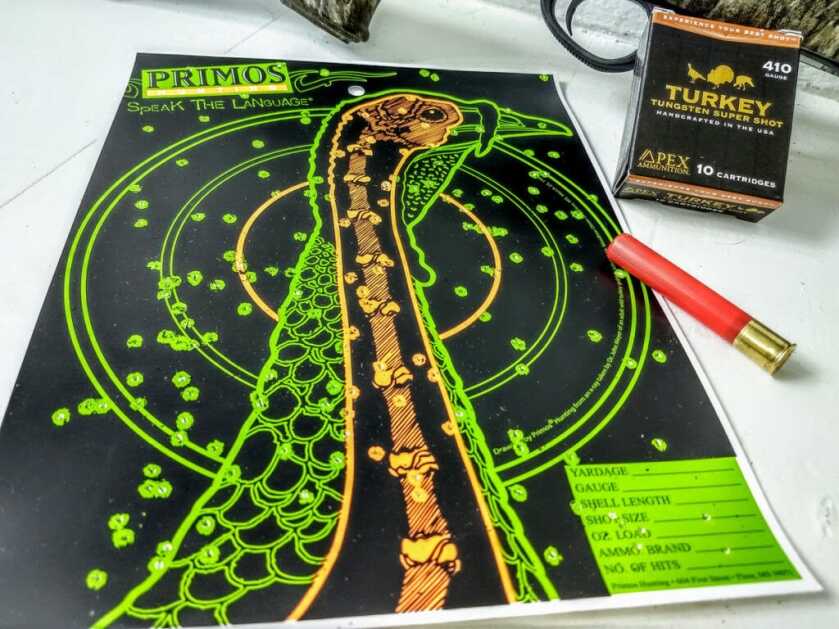
Turkey hunters like to say, “It takes just one pellet!” But I prefer eight to ten in the vitals especially given how tough a big tom can be to bring down. At 40 yards, all the loads met this self-imposed requirement. On average, the APEX placed 8 pellets in the target vital zones, the Browning 9, and the Federal 10. In fact, my very last target was with the Federal TSS at 40 yards and it recorded an impressive 13 pellet strikes in the vital zones.
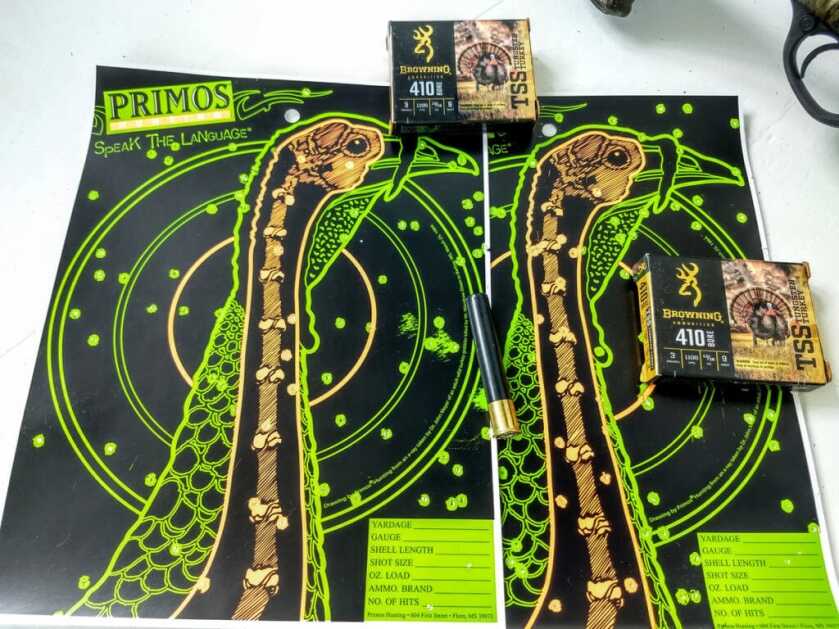
I was using, as noted, a full choke on the PS Turkey Hunter. I’d bet an Extra Full or Turkey choke could squeeze out a few more yards. Maybe five?
And there may be specific shotguns that are even better fits for the TSS shells I tested and could extend that range a bit more or make the pellet counts even higher at the above-tested distances.
The Hunt
The Wisconsin Department of Natural Resources breaks up our spring turkey hunt into six time slots, each slot seven days long and divided over seven Wild Turkey Management Zones. My tag was good for the May 20 to 26, 2020 slot.
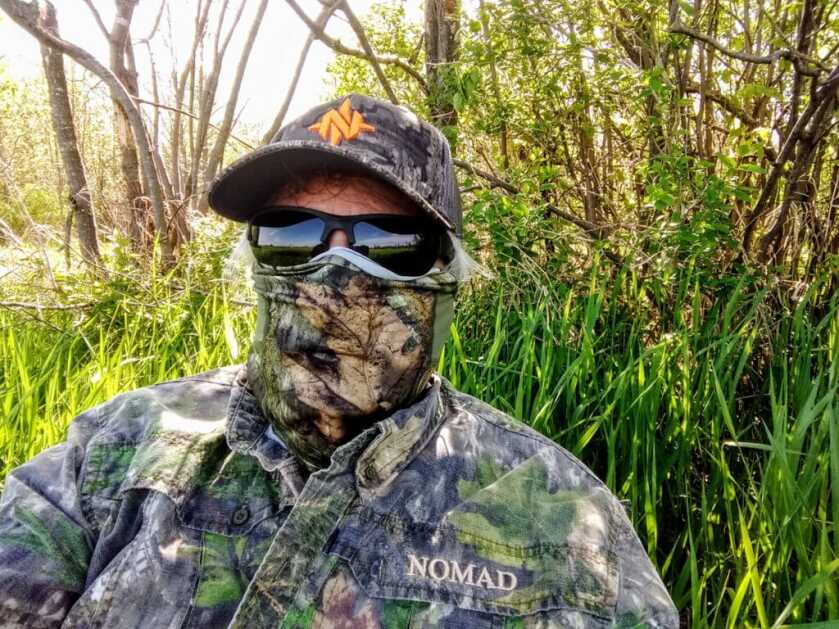
I hunted several days but didn’t see a turkey or hear a gobble, although both occurred the week before while I was scouting.
Yet, it was helpful to get out in the field. For this first time hunting with a .410, I decided on a 30-yard limit for a shot. I got into various sets and used my rangefinder to plot my limits and landmarks. Then, I’d line up my RDS on that stump at 18 yards, that tuft of grass at 28 yards, and take a few dry fire shots.

I was disappointed that not even a jake showed up, but I felt very confident with my .410 rig. So much so, I will definitely be afield this fall, trying for a tom with a .410 bore shotgun.


The 410 is not a kids gun, it is an experts gun. I’ve shot several turkeys with a Beretta 682 tubed skeet gun. 410 tubes, Brilly 410 full chokes, and #8.5 shot… same gun same load I shot skeet with for years. Why did I use a 410? Most of the time it was because that was simply how the gun was set up already. A couple times it was because all the ammo I had was a few 410’s!
Turkeys have never been hard to kill. If you can hit a skeet target crossing at 30 mph, a bobing turkey head is a piece of cake. They have great eyesight but are dumber than a box rocks. Just call them in close, that is the fun of a turkey hunt… at least to me.
I love the .410 and own a number of them from the .45/.410 T/C Contender to a number of double and single barreled long guns. I suppose that Toms can be taken with them but why should one limit themselves? Hunting turkey with a .410 seems to me as being close to hunting rhino with a .30/30. I suppose it can be done, but why? The chances of wounding and loosing your animal seems to me as being way too high.
Good Day Sir Brian, As a fellow Wisconsinite, I decided to try the .410 this year as well. TSS made me a 20ga convert since Federal first released it. Knowing the success I have had, the .410 intrigued me. I purchased a single shot CVA Scout V2 .410 which came with a JEBS .381 Turkey Choke. I patterned the same shells you selected with different results. My best performer was the Browning TSS with 15 vital hits @ 40 yards. The Apex was a close second and the Federal was not viable beyond 30 yards. Maybe the Federal would have liked a more open .385-.390 choke ? I thought the Apex would have dominated with the higher #9.5 pellet count over the Browning #9…Great job Browning ! I updated my Scout with a Optima Thumbhole Stock and used an older Bushnell Holosight I already owned. This CVA Scout V2 turned out to be a great “one shot challenge” combo. I always carry my range finder to establish my distances when runnin’ & gunnin’. On my hunt, I called in a group of Toms and took the best shot presented…dumped him in his tracks ! Laser confirmed at 44 yards. Couldn’t tell this wasn’t a 12 or 20ga the way he went down. What impressed me the most was when I cleaned my bird, there was only had one BB in the breast. I am hooked on this .410 challenge and I am certain my girls will enjoy shooting this combo over our 12 or 20ga. In my range testing before the hunt, I learned that the .410 requires a precision optic of some type over the normal bead type sight. The pattern is too small and there is no margin of error for clean kills as found with a 12 or 20. All in all, I am hooked and I know you will be when you connect with your first .410 Tom. Best Wishes and Safe Hunting !